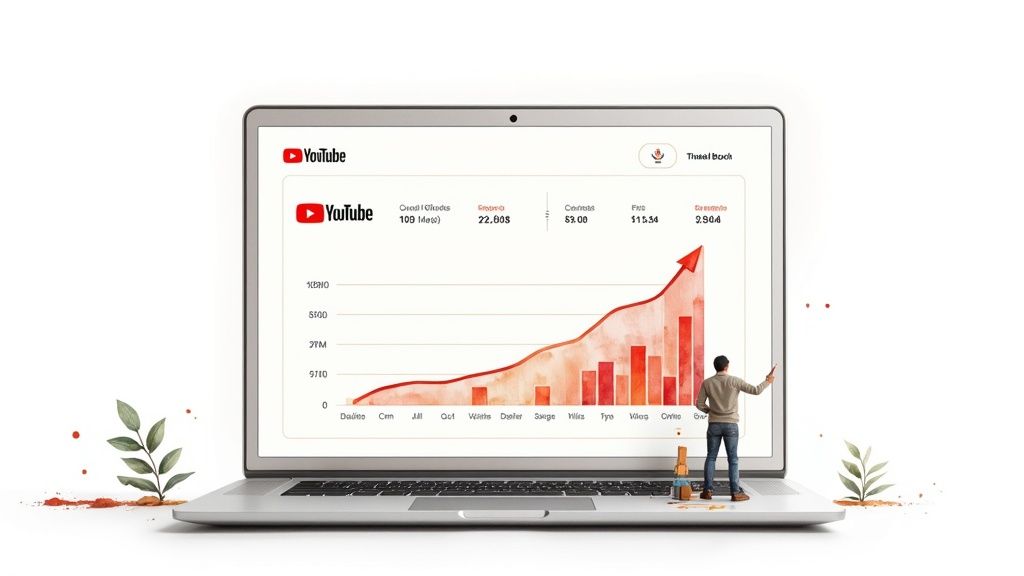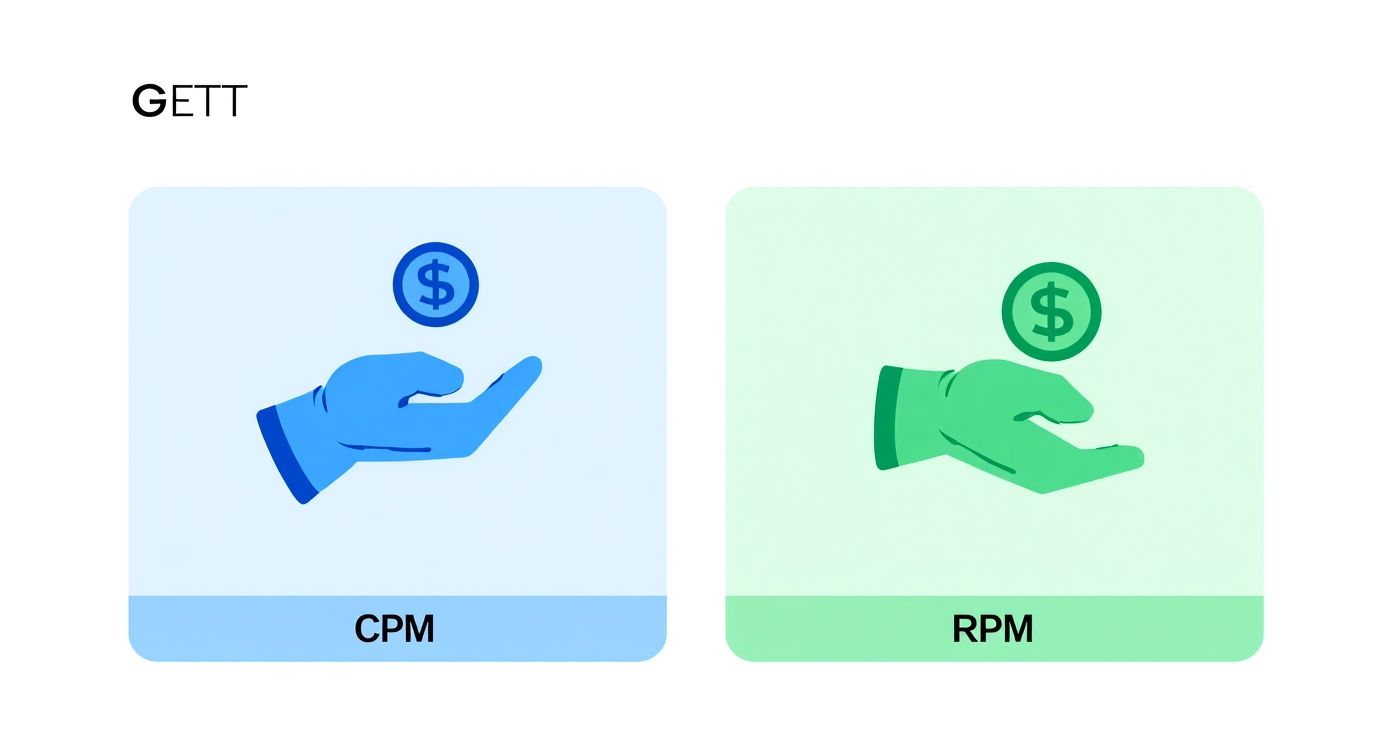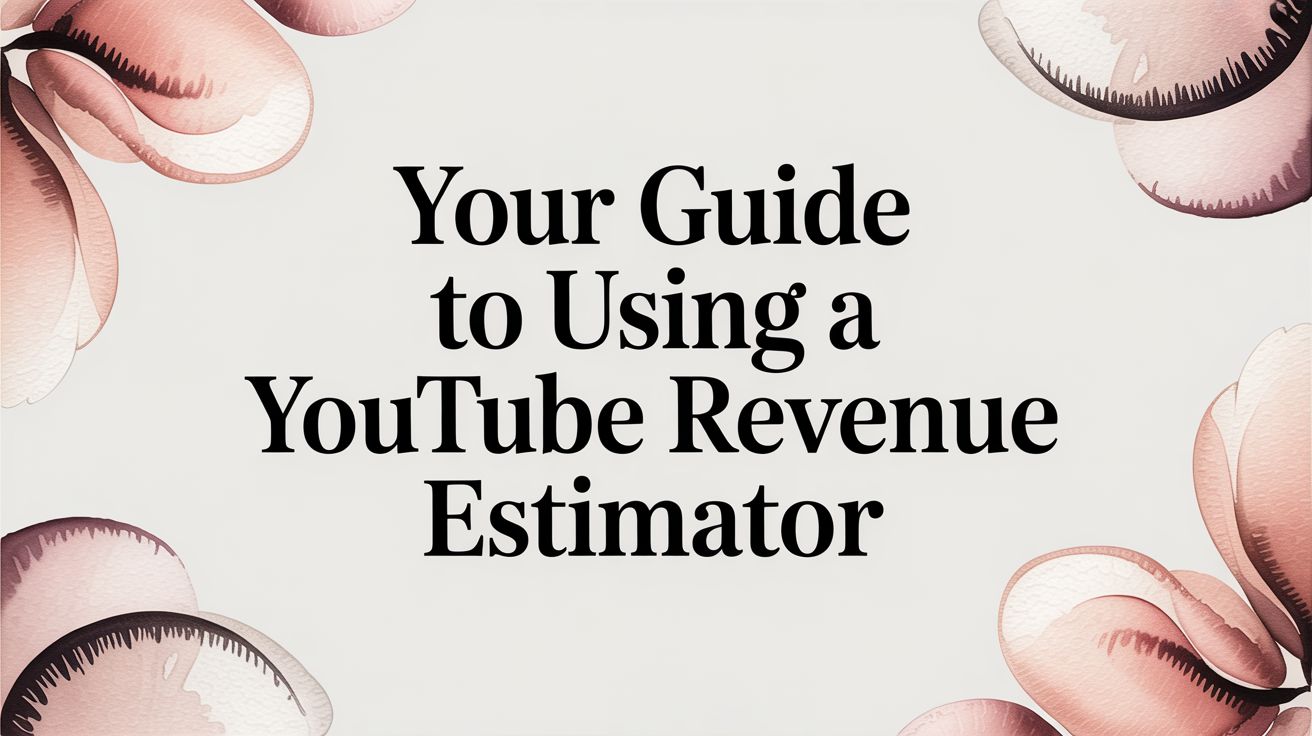Ever wondered how much a YouTube channel really makes? A YouTube revenue estimator is a tool that tries to answer that question, giving you a forecast of potential earnings based on things like view counts and typical ad rates.
Think of it as a ballpark figure. It’s a great starting point, but your actual take-home pay can swing quite a bit depending on your specific niche, where your audience lives, and how much they engage with your videos.
How a YouTube Revenue Estimator Actually Works

So, what's going on under the hood of a YouTube revenue estimator? It’s basically a financial crystal ball for your channel. These tools grab publicly available info, like how many views and subscribers you have, and mix it with industry-average advertising costs to spit out a surprisingly solid estimate.
It’s a lot like a weather forecast. It uses the data it has right now to predict what's likely to happen, but a dozen different variables can change the final outcome. Let's break down how these calculators get to their numbers so you know what those estimates truly represent.
The Basic Calculation Behind the Scenes
At its heart, the math is pretty straightforward. A revenue estimator takes your video's view count—say, over a day or a month—and multiplies it by an estimated CPM. That stands for Cost Per Mille, which is just a fancy way of saying the cost per 1,000 ad views.
The tool has to make an educated guess on that CPM number, usually based on your channel's topic and the primary country your viewers are from.
For instance, if your videos pull in 100,000 views a month and the tool pegs your CPM at $10, it'll estimate your gross ad revenue at around $1,000. But that's just the first step.
A YouTube revenue estimator provides a well-informed guess, not a guarantee. Use it as a helpful benchmark for setting goals, but remember that actual earnings will vary based on your specific audience, niche, and video engagement.
Key Data Points Estimators Use
To get closer to a real number, these tools look at a few key inputs. The more information you can give it, the sharper the estimate will be.
- Daily Video Views: This is the big one. It's the raw number of eyeballs you're getting, which translates directly to potential ad impressions.
- Engagement Rate: Things like likes, comments, and shares are a huge signal to advertisers that you have a loyal, active audience. That's pure gold.
- Channel Niche/Category: The calculator knows that ad rates are wildly different across categories. A video about personal finance will have a much higher CPM than a gaming channel, for example.
- Audience Location: A viewer from the United States or the United Kingdom is generally worth more to advertisers than a viewer from a country with lower ad spending, and the tool adjusts for that.
Let’s quickly look at what data a revenue estimator takes in and what kind of earnings it spits out.
Estimator Inputs vs Outputs Explained
A quick look at the data a revenue estimator uses and the potential earnings it calculates for you.
| Input Data Point | Why It Matters | Example |
|---|---|---|
| Video View Count | The foundation of all calculations—more views mean more potential ad impressions. | A channel owner enters "50,000 views per day." |
| Content Niche | Determines the average ad rates (CPM) the calculator will apply to your views. | A creator selects "Finance & Investing" as their category. |
| Audience Region | Adjusts the estimated CPM based on the economic value of the audience's location. | The user specifies their primary audience is in the "United States." |
| Engagement Metrics | High engagement can signal a loyal audience, leading to higher ad bids. | The estimator might factor in an above-average like-to-view ratio. |
As you can see, the tool is trying to build a profile of your channel to make the best possible guess. It’s a simple process of input and output, but it gives you a powerful glimpse into your channel's financial potential.
Getting to Grips with YouTube's Money Lingo
Before you can even begin to guess what your channel might earn, you need to speak the language. A few key terms pop up again and again, and they’re not just jargon—they are the numbers that directly decide how much money you actually make.
The two big ones you’ll hear constantly are CPM and RPM. They sound alike, but they tell two very different stories about your earnings. Nailing the difference is the first real step to understanding your channel's financial potential.
CPM: What Advertisers Are Paying
Think of CPM, or Cost Per Mille, as the raw price tag. It’s what an advertiser agrees to pay for every 1,000 times their ad gets shown on a video. It's the total pot of money before YouTube takes its cut.
For instance, an advertiser in a high-value niche like personal finance might pay a $30 CPM. That means they're shelling out $30 for every thousand ad views. This number is a fantastic signal of how much advertisers value your audience, but it's not the number you'll see in your bank account.
RPM: What You Actually Take Home
This is where RPM, or Revenue Per Mille, comes in. This is the metric that matters to you. RPM shows your total estimated earnings—from all sources like ads, Super Chats, and Memberships—for every 1,000 video views, after YouTube has taken its share.
Let’s use an analogy. If CPM is the price advertisers pay for a whole pizza, YouTube takes its slice first (which is a 45% cut of ad revenue). Your RPM is the money you make from the slices left over, for every 1,000 times your video is viewed. And since not every single view gets an ad, your RPM will almost always be lower than your CPM.
The Bottom Line: CPM is what advertisers spend. RPM is what you earn. Your main goal as a creator is to increase your RPM, as that’s the number that directly grows your income.
Getting this distinction is everything. A high CPM is great, but it’s only potential. Things like where you place your ads and how long people watch your videos are what turn that potential into actual cash in your pocket—your RPM.
Beyond CPM and RPM, a few other factors have a massive impact on your final payout. They all feed into your RPM and determine how accurate any earnings estimate can be.
- Ad Fill Rate: This is simply the percentage of views that actually showed an ad. A 100% fill rate almost never happens. Viewers might use ad blockers, or maybe there just aren't any ads available for them to see.
- Watch Time: The longer people watch, the more chances you have to show them mid-roll ads. This is a huge deal for videos over eight minutes long and can seriously pump up your RPM.
- Audience Retention: If viewers click away in the first 30 seconds, they’re not going to see any of those valuable mid-roll ads. Keeping them hooked means they're more likely to sit through multiple ads in one video.
Why Your Niche and Audience Location Matter Most
Let's get one thing straight: not all YouTube views are created equal. This is probably the biggest source of confusion for new creators, and it's the key to understanding your real earning potential. The two factors that will make or break your channel's income are your niche (the topics you cover) and the location of your audience.
Think about it from an advertiser's perspective. They aren't just buying views; they're buying access to a specific type of person. A company selling high-end investment software will pay top dollar to place their ad in front of people watching finance videos. Why? Because every single viewer is a potential customer. That same company probably won't spend a dime advertising on a prank channel.
This infographic breaks down the crucial difference between what an advertiser pays (CPM) and what you, the creator, actually get (RPM).

As you can see, the CPM is the total cost to the advertiser. RPM is what's left for you after YouTube takes its share.
The Power of a High-Value Niche
Your niche is the biggest piece of the puzzle. Any decent YouTube revenue estimator has to start here. A channel that dives deep into personal finance, real estate, or tech reviews is going to attract much higher ad rates than one focused on general vlogs or gaming highlights.
It's simple economics. Advertisers in profitable industries just have more money to spend and are willing to pay more for a perfectly targeted audience. This creates a huge difference in how much you can earn.
- High-CPM Niches: Think finance, technology, marketing, health, and education. These topics pull in advertisers who are selling expensive products or services.
- Low-CPM Niches: Gaming, lifestyle vlogs, and comedy usually fall here. They can get massive audiences, but the ads are typically for lower-priced, mass-market goods.
Seriously, a single view on a finance channel from someone in the United States could be worth 10 times more than a view on a gaming channel.
How Audience Location Changes Everything
Just as important as what your audience is watching is where they're watching from. Advertisers pour more money into countries where people have more spending power. This makes viewers from "Tier 1" countries like the US, UK, Canada, and Australia incredibly valuable.
A view from a user in the United States is worth significantly more than a view from a region with lower overall ad spending. This is why channels with a primarily American or European audience often see much higher RPMs.
For example, a creator with 100,000 views from a US-based audience might easily earn more than another creator with 500,000 views from a country where ad budgets are tight.
To give you a clearer picture, here’s a rough breakdown of how much CPMs can vary across different niches and major regions.
Estimated CPM Ranges by Niche and Top Regions
| Content Niche | Typical CPM Range (USA) | Typical CPM Range (India) | Typical CPM Range (UK) |
|---|---|---|---|
| Personal Finance & Investing | $12 - $45 | $1 - $5 | $8 - $30 |
| Technology & Software Reviews | $10 - $35 | $0.80 - $4 | $7 - $25 |
| Health & Fitness | $6 - $20 | $0.50 - $3 | $5 - $15 |
| Gaming & Entertainment | $2 - $10 | $0.20 - $1.50 | $2 - $8 |
As you can see, the difference is massive. A finance creator targeting a US audience operates in a completely different financial world than a gaming creator with an audience in India.
The numbers don't lie. YouTube's ad revenue is projected to hit an incredible $39 billion in 2024, which shows just how much brands are willing to invest to reach the right people in the right places.
If you can find a niche that keeps people watching for long periods, you'll be in an even better position. To learn more about building a channel that consistently engages viewers, you might want to check out these evergreen streaming ideas. Once you grasp these two core concepts—niche and location—you can start building a content strategy that truly maximizes your earning potential from day one.
Looking Beyond Ads to See Your Full Potential

Relying on ad revenue alone is like trying to build a house with only one type of tool. It might work, but it's not the most stable or efficient way to do it. While a YouTube revenue estimator is great for calculating ad payouts, seasoned creators know that a diversified income is the key to real, long-term growth. Ads are just the beginning.
Once you’re in the YouTube Partner Program (YPP), you unlock a whole suite of monetization features that go way beyond simple ads. These tools are all about building a direct connection with your biggest fans, turning them from passive viewers into active supporters.
Unlocking Predictable Monthly Income
One of the best tools for this is Channel Memberships. Think of it as creating your own VIP club. You can offer cool, exclusive perks—like custom emojis, behind-the-scenes videos, or special badges—to fans who pay a small monthly fee to join.
This creates a predictable, recurring income stream that can be a real lifesaver. Ad revenue can swing wildly from month to month, but membership fees provide a stable base you can count on. That stability makes it so much easier to plan your content and budget.
Remember, for traditional video ads, YouTube gives you 55% of the revenue and keeps 45%. By adding memberships, you're creating a separate income stream that you have much more control over. For a deeper dive into these numbers, check out the stats on YouTube's revenue models over at BloggingWizard.
Capitalizing on Live Engagement
Going live opens up a whole different world of earning potential, mostly through direct fan funding. These features are built to make your streams more engaging for your audience and more profitable for you.
- Super Chat: Viewers can pay to have their comment highlighted and pinned at the top of the chat during a live stream. The more they pay, the longer it stays there, guaranteeing you’ll see it.
- Super Stickers: This is a fun, visual way for fans to show support. They can buy animated stickers that pop up in the chat feed, grabbing everyone's attention.
- Super Thanks: This isn't just for live streams. Viewers can show their appreciation on your regular videos and Shorts by purchasing a "Super Thanks," which leaves a colorful, animated "thank you" on their comment.
These tools aren't just about making money—they're about building community. When a fan gets a shout-out because of their Super Chat, they feel seen and valued, which makes them want to stick around for the long haul.
Integrating Your Brand with YouTube Shopping
Finally, YouTube Shopping lets you turn your channel into a storefront. You can connect your own merchandise store or promote products from other brands right below your videos.
By tagging products in your content, you make it incredibly easy for viewers to buy something they like without ever leaving the page. Whether you're selling your own t-shirts or promoting affiliate products, it adds a powerful and scalable revenue stream that puts your brand first.
When you start combining all these methods, you'll see a much bigger, more exciting picture of what your channel can truly earn.
Actionable Strategies to Increase Your Earnings
A YouTube revenue estimator shows you what's possible, but these are the strategies that will actually help you get there—and hopefully, blow right past those initial numbers. It's time to stop thinking about estimates and start actively shaping the metrics that control your income.
The bedrock of earning more is simply increased watch time. The longer people watch, the more chances YouTube has to show them ads, and that's what directly pumps up your RPM. Every creative decision you make should have one goal in mind: keeping viewers locked in.
Boost Engagement and Watch Time
To get more watch time, you need to grab people's attention and refuse to let it go. Work on strong intros that clearly state the video's value and then make sure the content delivers on that promise. Videos longer than eight minutes are especially golden because they unlock mid-roll ads, which can be a huge boost to your revenue.
Of course, you first have to get them to click. That’s where compelling thumbnails and titles come in. A great click-through rate means more viewers in the door, and consistent, high-quality content is what makes them stay. For a closer look at making your videos more appealing, check out our guide on how to optimize your videos for YouTube.
Key Takeaway: Longer watch sessions aren't just a vanity metric in your analytics. They're a direct signal to YouTube's algorithm to serve more ads, which is how you make more money per thousand views.
Target High-Value Niches and Audiences
As we've covered, not all views are created equal. You can seriously increase your earning potential by creating content in high-CPM niches like finance, technology, or business education. A little keyword research can uncover topics in these areas that people are searching for but few are covering well.
At the same time, think about who you're making videos for. Content that appeals to audiences in Tier 1 countries (think the USA, UK, and Canada) is incredibly valuable. Advertisers spend more to reach these viewers, so every view from these places is worth a lot more. The language you use, the cultural references you make, and the topics you choose can all be tweaked to attract this audience.
Diversify Your Revenue Streams
Finally, don't put all your eggs in the ad-revenue basket. YouTube gives you plenty of other ways to make money, and you should be actively encouraging them.
- Channel Memberships: Offer exclusive content, behind-the-scenes access, or special badges to fans for a recurring monthly fee.
- Super Chat & Stickers: During live streams, give your biggest fans a way to stand out and support you directly.
- YouTube Shopping: Sell your own merch or link to affiliate products right below your videos.
Getting more eyeballs on your content is always a good thing, and that's true for every format, including Shorts. You can find some great strategies to get more views on YouTube Shorts to help you grow. When you start combining all these methods, you transform your channel from a hobby that makes a little ad money into a real, multifaceted business.
Got Questions? We've Got Answers
Even with all this info, you probably still have a few questions floating around. That's perfectly normal. A YouTube revenue estimator is a fantastic tool for getting a ballpark figure, but let's clear up some of the common uncertainties creators have.
Just How Accurate Are These Estimators?
Think of a revenue estimator as an educated guess, not a crystal ball. They work by crunching public data and industry averages, which is great for a general forecast.
But they can't peek behind the curtain at your channel's specific, private analytics. So, use it as a starting point to set some goals, but know that your actual earnings will dance to the beat of your own audience, content niche, and engagement metrics.
Do I Need to Be Monetized to Use an Estimator?
Nope, not at all! In fact, these tools are incredibly useful for creators who are still on the path to monetization. They let you run some "what-if" scenarios and see the potential before you even hit the YouTube Partner Program eligibility requirements.
Of course, to turn those estimates into actual cash, you'll need to get your channel officially approved for the program first.
Key Takeaway: Always remember that CPM is what advertisers pay per 1,000 ad views. Your RPM is what you actually earn after YouTube takes its share. Your RPM will always be lower than the CPM, so keep that in mind when you're looking at estimates.
Ready to fast-track your channel's growth and hit those monetization goals sooner? Broadcasting your content 24/7 is a game-changer. 24/7 LiveStream keeps your channel active around the clock, supercharging your watch time and keeping your content in front of a global audience. Learn more and get your always-on stream running today.
